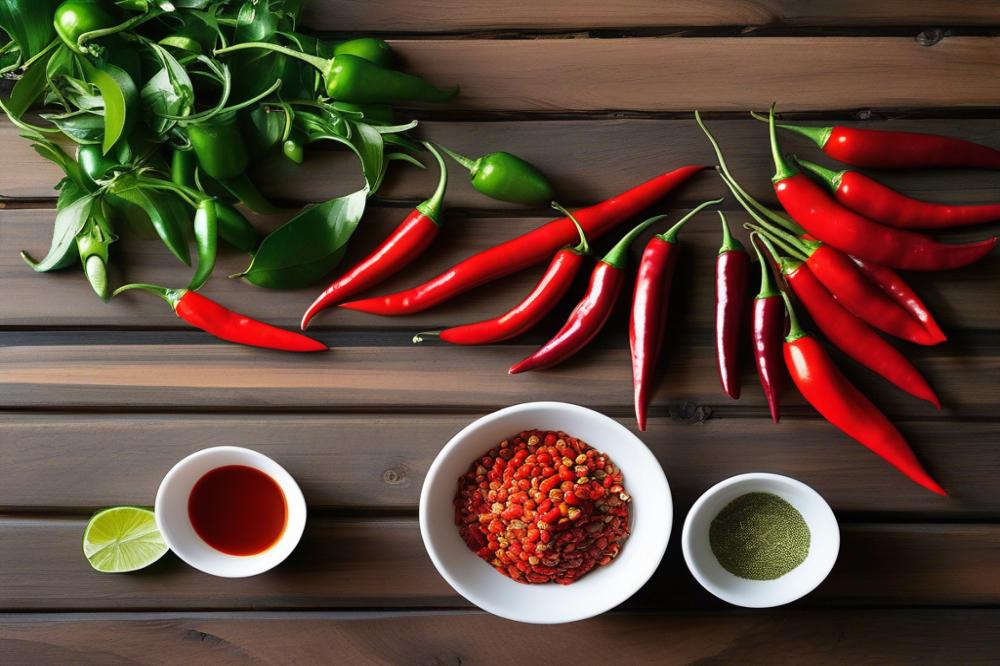Growing Thai Dragon Chili for Spicy Asian Recipes
Thai Dragon Chili is a vibrant variety of pepper celebrated for its fiery heat and rich flavor. This particular chili finds its place in many Asian dishes, adding spice to stir-fries, salads, and sauces. Its distinct taste enhances numerous recipes, making it a favorite among those who enjoy cooking with bold flavors. As more home cooks explore the world of spicy recipes, the popularity of growing chili peppers at home has surged.
Cultivating chili plants allows individuals to access fresh and flavorful ingredients right from their gardens. Not only does this practice support flavorful cooking, but it also provides a rewarding hobby. Many who enjoy Asian cuisine find immense satisfaction in nurturing plants and watching them flourish. The experience of picking ripe chilies straight from one’s own garden can hardly be matched.
In this article, several gardening tips will be shared to assist readers in successfully growing their own Thai Dragon Chili. Topics will include essential plant care, ideal conditions for chili cultivation, and how to manage heat levels for optimal flavor. With the right knowledge, anyone can grow these pepper varieties, enhancing their culinary adventures with homegrown ingredients. Let’s dive into the journey of raising these exciting plants!
Understanding Thai Dragon Chili


The Thai Dragon Chili is a small yet striking pepper. It typically measures between two to three inches in length and has a slender, elongated shape. Its skin is smooth and glossy, often showcasing a bright red or green hue, which adds a vibrant touch to any dish. These peppers grow on upright plants that can reach heights of about two feet, making them suitable for home gardening. Proper plant care is essential to achieve healthy growth and bountiful yields.
Flavor-wise, this chili pepper offers a sharp, punchy taste. Its initial bite is intense, often followed by a lingering heat that many find appealing. Heat levels can vary, but on the Scoville scale, it generally rates between 50,000 to 100,000 Scoville Heat Units. This fiery profile makes it a beloved choice for those who enjoy spicy recipes, especially in Thai cuisine.
Culinary uses for the Thai Dragon Chili are extensive. Many traditional Thai recipes incorporate this pepper, whether in spicy soups, salads, or stir-fries. Its heat can enhance the flavors of various Asian dishes, imparting a depth that elevates the overall dining experience. Furthermore, these peppers can also be dried and crushed to create chili flakes, providing an easy way to spice up everyday meals.
This pepper variety is not just popular in Thailand. Other Asian countries also embrace it, using it in their own cooking styles. From Korean kimchi to Vietnamese pho, its versatility shines through in many forms. Fans of Asian cuisine appreciate how it brings a distinctive kick without overwhelming other ingredients.
For those interested in gardening tips, cultivating Thai Dragon Chili can be very rewarding. This pepper thrives in warm climates and requires plenty of sunlight. Regular watering and well-drained soil are crucial for optimum growth. When grown at home, it brings the joy of harvesting fresh peppers right from your garden.
Whether you’re a seasoned chef or a newcomer to cooking, incorporating this pepper can transform dishes. Its dynamic flavor and heat level make it a favorite among food enthusiasts. Exploring the possibilities of this chili enhances not only recipes but also the culinary journey into Asian flavors.
Chili Cultivation Basics


Chili cultivation can be a rewarding hobby. Growing peppers, such as the Thai Dragon variety, requires attention to detail and care. The first step is understanding the ideal growing conditions.
Warm temperatures are crucial for optimal growth. A range of 70 to 85 degrees Fahrenheit is perfect. Strong sunlight plays a vital role, too. Aim for at least six to eight hours of direct sunlight daily. In addition to heat and light, soil quality is paramount. Well-drained, loamy soil enriched with organic matter creates a fruitful environment.
Home gardening provides numerous benefits. It allows easy access to fresh ingredients. Growing herbs and spices at home can enhance your culinary experience. Incorporating Thai recipes into your meals becomes effortless when you have fresh chili at your fingertips.
Watering is another significant factor in plant care. Keeping the soil consistently moist, but not soggy, is essential for healthy growth. Be cautious, too, as overwatering can lead to root rot. Monitor your plants closely, adjusting water levels according to weather conditions.
When selecting seeds, consider different pepper varieties. Some may be hotter than others, adding diverse heat levels to your spicy recipes. Proper spacing is also crucial for growth. Crowding the plants can restrict airflow, leading to diseases.
Fertilizing during the growth phase helps boost yields. Organic fertilizers work well to provide necessary nutrients.
Lastly, regular pest management should not be overlooked. Inspect the plants routinely for any signs of pests or disease. Early intervention can save your crop and ensure a successful harvest. Embracing these gardening tips can elevate your home gardening experience, resulting in bountiful harvests. Enjoy the journey of cultivation while you prepare for flavorful Asian cuisine!
Plant Care and Maintenance


Caring for chili plants is essential for robust growth. Watering is critical during the growing season. These plants prefer consistent moisture. Water them thoroughly once a week, but check the soil moisture first. Too much water can lead to root rot, while too little can stress the plant.
Fertilization practices significantly influence yield and flavor. Use a balanced fertilizer every four to six weeks. A formula high in potassium and phosphorus is ideal for developing fruit. Additionally, organic options like compost can enhance soil health. Well-fed plants tend to produce spicier fruits suitable for many Asian recipes.
Pest control is another important aspect of plant maintenance. Regularly inspect the leaves for common pests like aphids and spider mites. Introducing beneficial insects like ladybugs can be effective. If pests appear, consider using natural insecticidal soap.
Monitoring for diseases is crucial in chili cultivation. Fungal infections can emerge, especially in humid climates. Avoid overhead watering to reduce moisture on leaves, which helps prevent such problems. Keeping plants spaced adequately promotes air circulation, minimizing disease risks.
Healthy plants produce vibrant and flavorful peppers. Without proper plant care, the yield will be disappointing. Optimal heat levels in the peppers often come from stress during growth, so consider not over-watering. Embracing these gardening tips can lead to bountiful harvests.
In home gardening, attention to detail makes a difference. Pruning can help improve airflow and sunlight exposure. Remove any dead or yellowing leaves regularly. Cultivating various pepper varieties alongside can provide a range of heat and flavor for your cooking.
Ultimately, nurturing your chili plants properly results in better culinary uses. Whether in spicy recipes or traditional Thai recipes, the quality of your harvest directly impacts the final dish. Enjoy the process of growing these unique peppers while savoring the fruits of your labor.
Harvesting and Storage


Harvesting Thai Dragon Chili requires attention and timing. The right moment to pick your chilies greatly affects their flavor and heat levels. Typically, these peppers are ready to be harvested around 75 to 90 days after planting. You can tell when they are ripe by their vibrant red color, which indicates maximum heat. Picking them too early may result in milder flavors, whereas late harvesting can lead to overly concentrated spice that may not suit all spicy recipes.
Carefully cut the stem with scissors or pruning shears. This method prevents damage to the plant and promotes further growth. Harvesting regularly encourages the production of more peppers, as the plant focuses its energy on remaining fruit when ripe chilies are taken off. Be sure to wear gloves when handling them, especially if your skin is sensitive to the heat.
Storage Techniques
Fresh chilies can be stored in a cool, dry place. Placing them in a paper bag allows for airflow, reducing moisture and prolonging freshness. Alternatively, you can keep them in the refrigerator, preferably in a crisper drawer. Use them within a week for the best flavor. For longer storage, various preservation methods can be applied.
Drying is an excellent option. Slice the chilies in half lengthwise and lay them out on a baking sheet. Utilize an oven set to a low temperature or a food dehydrator. This process removes moisture, intensifying their flavor. Once completely dried, store them in an airtight container away from light to maintain their heat levels.
Freezing for Future Use
Another method involves freezing. After washing and drying the chilies, slice them or leave them whole, depending on your future cooking needs. Place them in freezer bags, ensuring to remove as much air as possible. Frozen chilies can last several months without losing their spicy essence. This technique is especially useful for those who enjoy cooking Asian cuisine throughout the year.
Each method of preservation offers its benefits. Dry chilies can be ground into powder for various culinary uses, while frozen ones are perfect for soups, stews, and stir-fries. Consider your preferred pepper varieties and how you plan to incorporate them in your Thai recipes when deciding on storage techniques. These gardening tips can help any home gardener maximize their chili cultivation success.
Incorporating Thai Dragon Chili into Recipes
Many people love spicy recipes, and incorporating the Thai Dragon Chili into dishes can elevate flavors significantly. This particular chili is a key ingredient in traditional Thai recipes. For instance, it adds a fiery kick to classic dishes like Pad Thai or Green Curry. Similarly, other Asian cuisine often takes advantage of this pepper’s heat and vibrant flavor. Dishes from Vietnamese or Malaysian kitchens also find room for this chili.
When using chili in cooking, it’s important to consider the heat levels. Some may find the spice overwhelming. Reducing the number of chilis or removing the seeds can lessen the fire. Alternatively, if you’re a spice enthusiast, consider adding more peppers to your dishes. Experimenting with different amounts can help you discover your personal heat preference.
Sample Recipes
One simple recipe is Spicy Thai Basil Chicken. Begin by sautéing garlic in oil, then add ground chicken and cook until browned. Toss in chopped Thai Dragon Chili, fish sauce, and basil. This creates a savory and spicy meal that pairs well with jasmine rice. Another option is to create a chili paste. Blend fresh chilies with garlic, salt, and lime juice. This paste serves as a great enhancement for dipping sauces or marinades.
For those who enjoy soups, a hot and sour soup can benefit from chili’s flavor. Start by simmering broth with mushrooms and tofu. Right before serving, stir in chopped chili for heat. The combination will excite your taste buds. In addition, consider adding it to stir-fries. Toss together your favorite vegetables with tofu or chicken, and include sliced chilies for extra punch.
Gardening Tips for Home Gardeners
Growing your own peppers offers numerous culinary uses. Start with proper plant care strategies. Ensure adequate sunlight and well-drained soil for robust growth. Regular watering matters, but don’t overdo it. This pepper variety thrives in warmer climates, so temperature control is key. Harvesting should occur when chilies are ripe, typically indicated by a change in color.
As you cultivate your own peppers, remember that different pepper varieties have varying spice levels. Familiarizing yourself with these differences can help in selecting the right ones for your recipes. From mild to extremely hot, there’s a chili perfect for every taste. Naturally, using homegrown chilies means fresher flavors in your meals. This is especially true in spicy Asian recipes where freshness shines through.
Final Thoughts
Growing your own Thai Dragon Chili can be a rewarding experience for any home gardener. This hot pepper brings a burst of flavor and heat to your dishes, making it a wonderful addition to your garden. Cultivating such a vibrant plant not only enhances your cooking but also provides the satisfaction of nurturing something from seed to spice.
Home-grown chilis are often tastier than what you find in stores. Freshness has a significant impact on flavor, and the thrill of picking your own peppers adds joy to meal preparation. These chilis can elevate many spicy recipes, allowing you to explore and create delightful meals that celebrate Asian cuisine. From stir-fries to salsas, the opportunities are endless when you use your own produce.
Experimenting with the growth and harvesting process can lead to new insights about gardening. Different techniques can yield various results, making the journey as enjoyable as the final product. Whether you are a seasoned gardener or just starting out, caring for these plants offers valuable lessons.
So, gather some seeds and get started! Embrace the creativity that cooking with home-grown Thai Dragon Chili brings. Each dish you prepare can reflect your culinary passion, bringing together flavor and fun. Discover the joy of gardening and cooking—all while adding a touch of heat to your meals.



